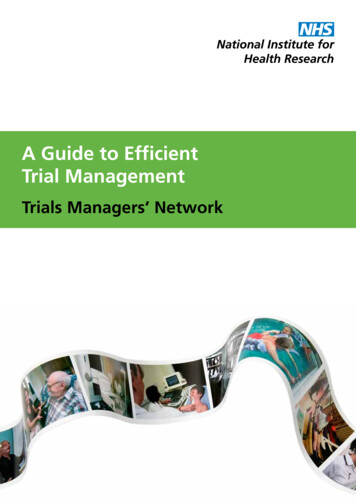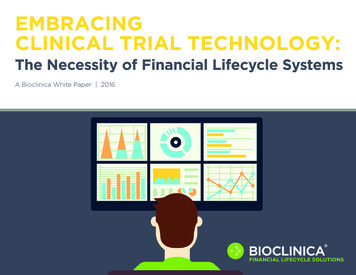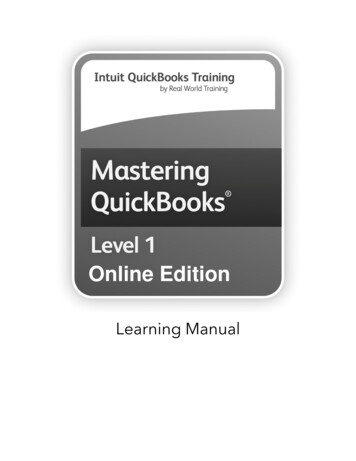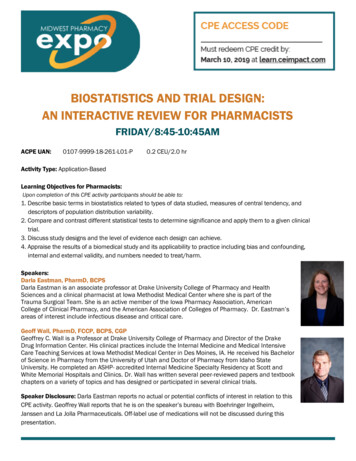
Transcription
A Guide to EfficientTrial ManagementTrials Managers’ Network
The Fourth Edition (2014) of the Guide to Efficient Trial Managementwas produced by an appointed Editorial Board and a dedicated group ofvolunteers on behalf of the NIHR Trial Managers’ Network, under the termsof a contract issued by the Secretary of State for Health.ISBN 9780854329748DOI: 10.3310/2014-Trial-Managers’-Network-GuideFourth Edition: January 2014 Queen’s Printer and Controller of HMSO 2014.
DOI: 10.3310/2014-Trial-Managers’-NetworkGuide to Efficient Trial Management 4th Edition January 2014AcknowledgementsThe National Institute for Health Research Trial Managers’ Network (TMN) would like to acknowledge allthose involved in the compilation of this new edition, in particular the editorial board members:Alison McDonald: Chairperson of editorial board and Senior Trials Manager, Centre for HealthcareRandomised Trials (CHaRT), University of Aberdeen.Athene Lane: Senior Research Fellow and Associate Director, Bristol Randomised Trials Collaboration.Barbara Farrell: Trial Director, National Perinatal Epidemiology Unit, University of Oxford.Janet Dunn: Deputy Director, Warwick Clinical Trials Unit, and Head of Cancer Trials, WarwickMedical School.Sarah Buckland: Director, INVOLVE.Sarah Meredith: Deputy Director, Medical Research Council Clinical Trials Unit.Vicky Napp: Operations Director, Clinical Trials Research Unit, University of Leeds.Svetozar Mihaylov: NIHR Trial Managers’ Network Coordinator, Clinical Trials Research Unit, Universityof Leeds.In addition, Barbara Farrell and Sara Kenyon were influential in producing the original and subsequenteditions of the Guide to Efficient Trial Management, out of which this fourth edition has evolved.Thanks should also be given to all volunteer contributors from across the UK clinical research environmentwho were involved in the preliminary review and contributed their knowledge and expertise to this edition.iii Queen’s Printer and Controller of HMSO 2014. Applications for commercial reproduction should be addressed to: NIHR Journals Library, National Institute for Health Research,Evaluation, Trials and Studies Coordinating Centre, Alpha House, University of Southampton Science Park, Southampton SO16 7NS, UK.
DisclaimersDisclaimersThis guide has been developed for general information and education purposes only and does notconstitute legal advice or opinions as to the current operative laws, regulations or guidelines ofany jurisdiction.In addition, because new standards and guidelines are issued on a continuing basis, the guide is notan exhaustive source of all current applicable laws, regulations and guidelines relating to interventionaland non-interventional trials. While reasonable efforts have been made to assure the accuracy andcompleteness of the information provided, Trial Managers and other individuals should check with therelevant research governance bodies, for example the Medicines and Healthcare products RegulatoryAgency (MHRA), Research Ethics Committees (RECs), and Research and Development (R&D) departments,before and during trials.Please note that guidance can change, so please use the relevant links to ensure you have the mostup-to-date information.iv
DOI: 10.3310/2014-Trial-Managers’-NetworkGuide to Efficient Trial Management 4th Edition January 2014Devolved nationsWhile most of the legislation and guidance provided in this guide is applicable to Trial Managers acrossthe UK, please note that devolved administrations within the UK may have some additional regulatoryrequirements and guidelines. Please refer to the relevant organisations for additional information (NHSResearch Scotland, National Institute for Social Care and Health Research, Welsh Government, or Health &Social Care in Northern Ireland).v Queen’s Printer and Controller of HMSO 2014. Applications for commercial reproduction should be addressed to: NIHR Journals Library, National Institute for Health Research,Evaluation, Trials and Studies Coordinating Centre, Alpha House, University of Southampton Science Park, Southampton SO16 7NS, UK.
Use of the guideUse of the guideThe content of this document can be accessed, printed and downloaded in an unaltered form by TrialManagers and other research professionals, with copyright acknowledged, for personal study that is notfor direct or indirect commercial use.The guide can also be used by Higher Education Institutions as a teaching and training aid, subject toappropriate recognition of the National Institute for Health Research (NIHR) and approval by theNIHR Evaluation, Trials and Studies Coordinating Centre (NETSCC).All enquires should be directed to NETSCC in the first instance.vi
DOI: 10.3310/2014-Trial-Managers’-NetworkGuide to Efficient Trial Management 4th Edition January ed nationsvUse of the guideviCommonly used termsixIntroduction 1Section 1 Understanding randomised trials1.1 Why do a randomised trial?1.2 Randomisation and methods1.3 Blinding (also known as masking)1.4 Placebos1.5 Sample size1.6 Power1.7 Confidence intervals1.8 Confounding1.9 Outcomes1.10 Types of trials22233344445Section 2 National infrastructure2.1 National Institute for Health Research, England2.2 UK Clinical Research Network (UKCRN)2.3 UK Clinical Research Collaboration (UKCRC)2.4 UKCRC Clinical Trials Unit Network77788Section 3 Regulatory framework for clinical trials3.1 Legislation and guidance3.2 Systems for approvals and permissions3.3 Permissions for participant follow-up991620Section 4 Trial planning and development4.1 Planning a grant application for a trial4.2 Public involvement4.3 Risk assessment4.4 The trial protocol4.5 Randomisation options4.6 Trial oversight4.7 Regular reporting2223252727292930vii Queen’s Printer and Controller of HMSO 2014. Applications for commercial reproduction should be addressed to: NIHR Journals Library, National Institute for Health Research,Evaluation, Trials and Studies Coordinating Centre, Alpha House, University of Southampton Science Park, Southampton SO16 7NS, UK.
ContentsviiiSection 5 Trial set-up5.1 Trial coordinating centre5.2 The trial team5.3 Equipment5.4 Trial identity and marketing5.5 Standard Operating Procedures5.6 Document development and design5.7 Trial Master File/Investigator’s Site File5.8 Trial information systems5.9 Investigator/site selection5.10 Checklist – before recruitment starts5.11 Managing the budget5.12 International trials32323233343434353638383840Section 6 During the trial6.1 Trial Master File/Investigator Site File6.2 Trial recruitment6.3 Retention and follow-up6.4 Data collection and management6.5 Data protection – the practicalities6.6 Monitoring6.7 Preparing for audit and inspection6.8 Drug management systems6.9 Safety reporting systems41414143444546475152Section 7 Trial closure7.1 End of the recruitment period7.2 Financial closure7.3 Informing investigators7.4 Extension to trial closure7.5 Early termination or temporary suspension of the trial7.6 Planned closure7.7 Site close-out7.8 For CTIMP trials: trial drug supplies7.9 Informing participants7.10 Informing the sponsor7.11 Informing the Health Research Authority545454545455555555565656Section 8 Preparation of final reports and publication8.1 Publication and dissemination5757Section 9 Archiving9.1 Destruction of essential documents5960References61
DOI: 10.3310/2014-Trial-Managers’-NetworkGuide to Efficient Trial Management 4th Edition January 2014Commonly used termsAdministration of Radioactive Substances Advisory Committee (ARSAC) The body from whichresearchers who want to administer radioactive medicinal products to human subjects need to obtainapproval before NHS R&D permission.Amendment A written description of a change or formal clarification. Substantial amendments (seebelow) to protocol or participant information/consent require REC, R&D and MHRA approval.Non-substantial amendments should be ‘notified’ to REC, R&D and MHRA.Case Report Form (CRF) Data collection tool provided by a sponsor in which the clinical data are recordedfor each participant, such as weight, laboratory results and symptoms.Chief Investigator The Lead Investigator with overall responsibility for the research. In a multisitetrial, the Chief Investigator has coordinating responsibility for research at all sites. The Chief Investigatormay also be the Principal Investigator at the site in which they work. In the case of a single-site trial,the Chief Investigator and the Principal Investigator will normally be the same person, referred to asPrincipal Investigator.Clinical Research Network The NIHR Clinical Research Network makes it possible for all patients andhealth professionals across England to participate in relevant clinical trials.Clinical Trials Authorisation (CTA) The regulatory approval for a clinical trial of a medicinal productissued by the MHRA.Clinical Trials Unit (CTU) Specialist units that have been set up with a specific remit to design, conduct,analyse and publish clinical trials and other well-designed studies. They have the capability to providespecialist expert statistical, epidemiological and other methodological advice and coordination toundertake successful trials. In addition, most CTUs will have expertise in the coordination of trials involvinginvestigational medicinal products, which must be conducted in compliance with the UK Regulationsgoverning the conduct of clinical trials resulting from the EU Directive for Clinical Trials.Competent Authority Organisation approving the testing of new drugs/devices or approving themarketing licences. In the UK, this is the MHRA.Coordinated System for gaining NHS Permission (CSP) Standard process for adoption ontoNIHR Portfolio of Studies in order to access NIHR Clinical Research Network (CRN) support and funding;streamlines the process for gaining NHS permissions by collating the information for global and localapprovals; researchers initiate this in the Integrated Research Application System (IRAS) by completing andsubmitting the CSP application form.European Clinical Trials Database (EudraCT) A database of all clinical trials in Europe, held since 1994in accordance with EU directive 2001/20/EC.Good Clinical Practice (GCP) A set of internationally recognised ethical and scientific qualityrequirements which must be observed for designing, conducting, recording and reporting clinical trials thatinvolve the participation of human subjects. See ICH-GCP.Good Manufacturing Practice (GMP) A quality assurance standard for producing investigationalmedicinal products.ix Queen’s Printer and Controller of HMSO 2014. Applications for commercial reproduction should be addressed to: NIHR Journals Library, National Institute for Health Research,Evaluation, Trials and Studies Coordinating Centre, Alpha House, University of Southampton Science Park, Southampton SO16 7NS, UK.
Commonly used termsGene Therapy Advisory Committee (GTAC) The ethics committee for clinical studies using geneticallymodified products; usually no REC approval is required.Health Research Authority (HRA) The purpose of the HRA is to protect and promote the interests ofpatients and the public in health research. The HRA works closely with other bodies, including the MHRAand NIHR, to create a unified approval process and to promote proportionate standards for complianceand inspection within a consistent national system of research governance.Indemnity Compensation for damage, loss or injury.Information Services Division (ISD) Scotland A division of National Services Scotland, part of NHSScotland. ISD provides health information, health intelligence, statistical services and advice that supportthe NHS in progressing quality improvement in health and care and facilitates robust planning anddecision-making.Integrated Research Application System (IRAS) A single, web-based system for completingapplications for the permissions and approvals required for health and social care research in the UK. Thevarious applications can be printed or submitted for this single system (includes REC, R&D, MHRA, GeneTherapy Advisory Committee).International Conference on Harmonisation (ICH) (Europe, USA, Japan) The body that definesstandards for the terminology, design, conduct, monitoring, recording, analysis and reporting of research.These standards give assurance that the reported results are accurate and credible and that the rights,integrity and confidentiality of all participants have been protected throughout. Section E6 of ICHdefines principles of good clinical practice (referred to as ICH-GCP). Research teams on a Clinical Trial ofan Investigational Medicinal Products (CTIMPs) in the UK must follow GCP requirements as detailed inMedicines for Human Use (Clinical Trials) Statutory Instruments; all non-CTIMP studies conducted within theNHS adhere to GCP according to the Research Governance Framework (RGF).International Standard Randomised Controlled Trial Number (ISRCTN) A simple numeric system forthe identification of randomised controlled clinical trials worldwide. Allows the identification of trials andprovides a unique number that can be used to track all publications and reports resulting from each trial.Investigational Medicinal Product (IMP) An unlicensed new drug, or an existing drug tested outside itslicence, or existing drugs tested against each other for their efficacy/safety.Investigator Researcher conducting the trial; those researchers leading the team are referred to as ChiefInvestigator or Principal Investigator.Investigator Site File (ISF) A file designed for use in organising and collating all essential documentationrequired to conduct a trial in accordance with the principles of GCP and the applicable regulatoryrequirements such as REC approval letter/correspondence, MHRA approval, blank CRF, staff CVs, delegationof duties log.Investigator Brochure A compilation of clinical and pre-clinical pharmacological/biological data relevantto the use of that IMP(s) in human subjects (one single brochure for all trials using the same IMP).ISO 14155 A European standard for the organisation and documentation of clinical trials formedical devices.Medicines and Healthcare products Regulatory Agency (MHRA) The organisation responsible forregulating all medicines and medical devices in the UK by ensuring they work and are acceptably safe.x
DOI: 10.3310/2014-Trial-Managers’-NetworkGuide to Efficient Trial Management 4th Edition January 2014Medicines for Human Use (Clinical Trials) SI 2004:1031 and subsequent amendments 2006:1928,2006:2984, 2008:941, 2009:1164, and 2010:1882 are the UK Statutory Instruments translating EUdirectives 2001/20/EC and 2005/28/EC into UK law, laying down the legal requirements for conductingCTIMPs in the UK.Monitor The person designated by the sponsor to perform site visits and conduct the monitoring process;for example, check whether or not there are any deviations from the protocol and that all source data arecorrectly transferred into the Case Report Forms.Multicentre A trial conducted according to a single protocol but carried out at more than one site and bymore than one investigator; one Chief Investigator oversees several local Principal Investigators.National Institute for Health and Care Excellence (NICE) Provides national guidance and advice toimprove health and social care. NICE’s role is to improve outcomes for people using the NHS and otherpublic health and social care services by producing evidence-based guidance and advice for health, publichealth and social care practitioners; developing quality standards and performance metrics for thoseproviding and commissioning health, public health and social care services; and providing a range ofinformation services for commissioners, practitioners and managers across the spectrum of health andsocial care.National Institute for Health Research (NIHR) Established by the Department of Health for Englandin 2006 to provide the framework through which the Department of Health can position, maintain andmanage the research, research staff and infrastructure of the NHS in England. The mission of the NIHR isto maintain a health research system in which the NHS supports outstanding individuals, working inworld-class facilities, conducting leading-edge research focused on the needs of patients and the public.National Research Ethics Service (NRES) Umbrella organisation responsible for all RECs across the UK(incorporated into HRA in 2013).NHS Information Centre for Health and Social Care (NHS IC) England’s central, authoritative sourceof essential data and statistical information for frontline decision-makers in health and social care.Non-substantial amendments Changes to the details of a trial that have no significant implications forthe subjects, the conduct, the management or the scientific value of the trial (sometimes referred to asadministrative amendments).Office for National Statistics (ONS) The UK’s largest independent producer of official statistics and therecognised national statistical institute of the UK.Patient and Public Involvement The process whereby research is carried out ‘with’ or ‘by’ members ofthe public rather than ‘to’, ‘about’ or ‘for’ them; for example, members of the public, such as patients,service users and carers, may comment on or develop research materials or become members of TrialSteering Groups.Participant/Patient information leaflet An information leaflet given to those who have been invited toparticipate in a trial. The leaflet is designed to provide the potential participant with sufficient informationto allow that person to make an informed decision on whether or not they want to take part.Personal Demographics Service The national electronic database of NHS patient demographic detailssuch as name, address, date of birth and NHS Number.Principal Investigator The lead person at a single site designated as taking responsibility within theresearch team for the conduct of the trial.xi Queen’s Printer and Controller of HMSO 2014. Applications for commercial reproduction should be addressed to: NIHR Journals Library, National Institute for Health Research,Evaluation, Trials and Studies Coordinating Centre, Alpha House, University of Southampton Science Park, Southampton SO16 7NS, UK.
Commonly used termsRandomised Controlled Trial (RCT) A trial in which two or more forms of treatment/care are compared;the participants are allocated to one of the forms of care in the trial, in an unbiased way.Research and Development (R&D) Often the name of the department within NHS hospitals giving NHSpermission to conduct research on those facilities with patients/staff.Research Ethics Committee (REC) The body authorised by NRES to review documents for research takingplace in the NHS, or social services. Some RECs specialise in clinical trials, or topics such as research inchildren. See NRES website for more detail and other types of research. All research in NHS/social servicesmust be reviewed by a UK REC.Research Governance Framework (RGF) Department of Health guidance for the conduct of researchwithin the NHS in England (refer to second edition, 2005).Research Passport A system for Higher Education Institution (HEI)-employed researchers/postgraduatestudents who need to undertake their research within NHS organisations, which provides evidence ofthe pre-engagement checks undertaken on that person in line with NHS Employment Check Standards[including Criminal Records Bureau (CRB) and occupational health].Serious Adverse Event (SAE) Any adverse event or adverse reaction that results in death, islife-threatening, requires hospitalisation or prolongation of existing hospitalisation, results in persistant orsignificant disability or incapacity, or is a congenital anomaly or birth defect.Site The NHS organisation in which trial activities and assessment are performed or the location(s) wheretrial-related activities are actually conducted. Each site/trust needs to give R&D approval (permission).Site-Specific Assessment An assessment performed to establish the suitability of a Principal Investigatorand a site for the conduct of research; site-specific assessments will be performed by the participating CRNfor each research site (NHS organisation), using a SSI (Site-Specific Information) form available in IRAS.Source data verification Checking the original data record, such as laboratory reports or patient medicalnotes, against what was transferred onto the CRF database.Standard Operating Procedure (SOP) Detailed written instructions designed to achieve uniformity of theperformance of a specific function.Statutory instrument (SI) A document that defines UK law in on a specific topic; for example,SI (2004/1031) The Medicines for Human Use (Clinical Trials).Substantial Amendment A change to the terms of the approval, given by either the competentauthority (MHRA in the UK) or the Research Ethics Committee, or a change to the protocol or any otherdocument submitted with the applications, which significantly affects one of the following: (i) the safetyor physical or mental integrity of trial participants; (ii) the conduct or management of the trial; (iii) thescientific value of the trial; or (iv) the quality or safety of any investigational medicinal product used.Summary of product characteristics (SmPC) A smaller version of an Investigator Brochure withdetails on pharmacological effects and side effects, but issued for a product that already holds amarketing licence.xii
DOI: 10.3310/2014-Trial-Managers’-NetworkGuide to Efficient Trial Management 4th Edition January 2014Suspected Unexpected Serious Adverse Reaction (SUSAR) A serious adverse reaction that isunexpected (i.e. its nature and severity is not consistent with the known information about that productfrom the Investigator’s Brochure or the SmPC) and suspected, as it is not possible to be certain of causalrelationship with the IMP.Trial Master File (TMF) File with essential documents held by the Chief Investigator/Sponsor.UK Clinical Research Network (UKCRN) Clinical Trials Unit Network Registered CTUs that havebeen awarded UKCRC Registration and provided evidence to an international panel of experts of theircapability to centrally coordinate multicentre trials (i.e. having overall responsibility for the design,development, recruitment, data management, publicity and analysis of a portfolio of trials), and that theyhave established robust systems to ensure conduct and delivery of trials to the highest quality standards.xiii Queen’s Printer and Controller of HMSO 2014. Applications for commercial reproduction should be addressed to: NIHR Journals Library, National Institute for Health Research,Evaluation, Trials and Studies Coordinating Centre, Alpha House, University of Southampton Science Park, Southampton SO16 7NS, UK.
DOI: 10.3310/2014-Trial-Managers’-NetworkGuide to Efficient Trial Management 4th Edition January 2014IntroductionBackgroundThe first edition of the TMN Guide to Efficient Trial Management was produced in March 2000. The thirdedition was last produced in 2006. It is from this third version that the current group of volunteers workingwithin trials research from all over the UK have come together to produce the new edition.PurposeThe guide is intended as a reference tool, providing pragmatic advice and guidance to all those involved inthe management of trials.It describes the process of managing trials and gives an overview of the trial management framework,both legal and operational, providing practical hints, tips and references to external resources. Itdocuments information, practical experience, research, analysis and reflection for the effective and efficientmanagement of trials.ApplicationThis guide contains useful information, guidance and references, and tools and resources. It is aimed atboth novice and experienced Trial Managers, and can be used as an induction tool with newly appointedstaff. It may also be useful to students aspiring to pursue a career in trial management.ScopeThe main focus is predominantly late-phase, interventional, academic trials. As many aspects of trialmanagement apply across all trials, Trial Managers of early Phase I and Phase II trials may also findaspects of this guide useful and applicable to their work.One of the main objectives was to produce an inclusive resource, relevant to trials of a wide range ofinterventions and not limited to Clinical Trials of Investigational Medicinal Products (CTIMPs).The content of the guide has potentially wider applicability and relevance to the management of otherwell-designed studies such as case–control and cohort designs.Limitations of the guideThis guide is not a legal document, nor is it intended to be comprehensive or exhaustive. It consolidatesinto one document key information, available evidence and practical experience relevant to the field oftrial management.1 Queen’s Printer and Controller of HMSO 2014. Applications for commercial reproduction should be addressed to: NIHR Journals Library, National Institute for Health Research,Evaluation, Trials and Studies Coordinating Centre, Alpha House, University of Southampton Science Park, Southampton SO16 7NS, UK.
Understanding randomised trialsSection 1 Understanding randomised trials1.1 Why do a randomised trial?Assessment of the risks and benefits of a new treatment or other intervention needs to be based onreliable evidence. The most reliable evidence is best obtained by carrying out randomised trials to compareoutcomes of similar groups of participants who receive either the new intervention or the current standardintervention or, if there is no current standard, a placebo (or no active treatment). These trials need to belarge enough to estimate the effects of an intervention or procedure with a high level of confidence.The group that does not receive the intervention being evaluated is called the control group. This groupmay receive the standard intervention or, if there is no standard intervention available, no intervention or aplacebo (dummy) intervention.Ethically, equipoise should exist for a randomised trial to be undertaken: that is, genuine uncertainty aboutthe additional benefits and risks of the new intervention over the current standard intervention.Randomised trials are the gold standard1 as they aim to minimise potential biases in the estimation ofthe effect of the intervention. The two primary ways of minimising bias are randomisation and blinding.Chance effects are minimised by including large enough numbers of participants.1.2 Randomisation and methodsRandomisationIn a randomised trial designed to evaluate a novel intervention versus control with equal numbers in eachgroup (1:1), random allocation of the trial intervention gives all participants the same chance of receivingthe new intervention or the control intervention.Allocation is independent of the characteristics of the participants, unless the allocation uses stratificationor minimisation; see Randomisation methods, below, and preferences or prejudices of the investigator andparticipants. This can be achieved only if concealment of intervention allocation is secure such that theinvestigator and participants are ignorant of, and unable to predict, the next intervention allocation.Randomisation methodszzzzzzzz2Simple randomisation – allocation decided by (the equivalent of) a random number table, acomputer program or the toss of a coin.Minimisation – improves balance between the groups in terms of important characteristics, especiallyin small samples. It is based on the idea that the next participant to enter the trial is more likely tobe allocated the intervention that would minimise the overall imbalance of selected characteristicsbetween the groups at that stage.Blocked (or restricted) randomisation – interventions assigned randomly within blocks to ensurebalance within the blocks. Blocks can be of any size, but a multiple of the number of interventiongroups is logical. The block size should be small and variable, and unknown to the investigators, toprevent predictability and maintain concealment.Stratified randomisation – gives a balance within subgroups defined by important variables suchas centre or country in a multicentre trial. Blocked randomisation must be used within each stratum.Stratification is not feasible for small studies or where many variables exist.
DOI: 10.3310/2014-Trial-Managers’-NetworkzzGuide to Efficient Trial Management 4th Edition January 2014Cluster randomisation – the unit of randomisation is not the individual participant being studiedbut groups of participants (clusters), GP patients or a village community. This design is particularlyappropriate when the intervention is at a group level. The overall sample size required is larger becausethe analysis is based on the cluster unit.1.3 Blinding (also known as masking)zzzzDouble blind – both investigator and participant are ignorant of the intervention allocation.Single blind – either the participant or the investigator is unaware of the intervention allocated.Usually it is the participant who is ‘blind’.Whether or not it is possible to blind the participant and the care-giver, the outcomes should be welldefined and objective and the person assessing the pre-specified outcomes should, whenever possible, beunaware of or blind to the intervention allocated.1.4 PlacebosPlacebos are dummy interventions often used in drug trials. Although more difficult to organise innon-drug trials of complex interventions, placebos are sometimes both feasible and desirable in thissetting. If there is no existing standard intervention, then giving the control group no active interventionis ethical, and blinding can be achieved by use of a placebo. The placebo must be pharmacologicallyinactive but identical in appearance and taste to the active intervention.Double-dummy placeboI
The Fourth Edition (2014) of the Guide to Efficient Trial Management was produced by an appointed Editorial Board and a dedicated group of volunteers on behalf of the NIHR Trial Managers’ Network, under the terms of a contract issued by the Secretary of State for Health. ISBN 9780










